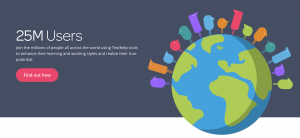We caught up with Martin McKay, Founder and CEO at Texthelp, to talk all things from helping people improve their written communication skills, to expanding to become the ‘FitBit’ for learning…
Tell us about Texthelp
Texthelp is a technology company helping students and lifelong learners of all abilities improve their reading, writing and maths skills, both in schools and in the workplace. Our mission is to help unlock everyone’s full ability and realise their potential through innovative technology.
Founded in 1996, we’ve been at the forefront of education technology over the last three decades. Our software suite of products includes Read&Write, EquatiO, WriQ, and Fluency Tutor which work alongside existing tools such as Microsoft Office and G-suite, enabling them to be integrated quickly into the classroom or workplace with ease. We have over 30 million users worldwide.
For learners, Texthelp’s products enable bespoke learning and support in the classroom environment, increasing engagement, confidence and outcomes. Our software makes formative assessment easier, helps boost engagement, identify knowledge gaps, and supports further, deeper learning. For senior leadership teams, Texthelp provides insight and data on closing the literacy gap, reducing teacher workload and delivering on accessibility and inclusion across all subjects.
How did you come up with the idea for the company?
Like many people in the assistive technology sector, I have a personal motivation.
All humans have a fundamental need to communicate. We all need to understand and we all need to be understood. When I was young, my dad had a severe stroke, and lost the ability to speak, read and write.
My dad could not express himself, and he really had difficulty understanding. At that time in the early 1980s there was no good assistive technology available and I thought I could do something positive about it. I started making assistive technology for people with profound communication disorders like CP, MD etc. After a few years, I was talking to a lady from a university in Scotland. She told me that 0.1 % of her students had CP, but that 10% had dyslexia, and if I could do something to help them I would be reaching many more people.
That started Texthelp’s work efforts in special education and over the past 20 years we have grown and reached a lot of students around the world. We have helped 30 million students directly with our education software, and probably twice that many people with our other website tools in use around the world.
More from Interviews
- A Chat with Kebbie Sebastian, CEO and Founder of Merge
- Meet Dr Agnès Leroy, GPU Director at Cryptography Tool: Zama
- Meet Roman Eloshvili, Founder of ComplyControl
- Inside Mobile Payments with Bojoko’s Ville Saari
- Meet Steve Haskew, Group Director of Sustainability and Growth At Circular Computing
- A Chat with Hakob Astabatsyan, CEO and Co-Founder of Synthflow AI
- Meet Ernesto Suarez, CEO at Travel Insurance Provider: Gigasure
- Under Pressure and On the Clock: Gurhan Kiziloz’s Nexus International to Hit $1.45B Revenue in 2025
How has the need for Texthelp software evolved during the pandemic?
Covid caused 1.5 billion children to be excluded from their school buildings this spring.
In order to keep teaching, kids online/distance learning became “must-do”. While unwelcome for a host of reasons, it has accelerated us towards a digital education environment.
Luckily, we have a few products that are a perfect fit. EquatIO, our maths product, was designed to “Make Math Digital” and its usage is up 10x since March. Usage of Fluency Tutor, our digital reading fluency practice and assessment tool, is up 4x since March too.
And our core literacy support product, Read&Write, has really come into its own. Our user acquisition rate is higher than ever, and it can help kids to work independently when the teacher is not in the room.

What can we hope to see from Texthelp in the future?
We are not going to forget our roots. Our purpose is to help people understand and help people be understood. We remain committed to that purpose. We are expanding our product range to help people in the workplace – we want to make the world’s websites easier to read. We are also making a bigger investment in learning analytics. We want to become the FitBit for learning. Our WriQ product is based on a world-leading analysis of 250,000 teacher-delivered writing assessments. We believe this can revolutionise writing assessment, and help students find their inner author.



